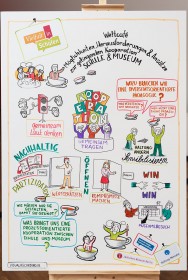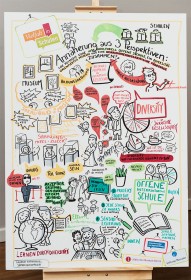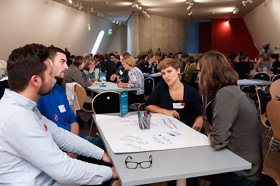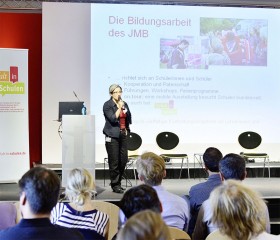
A “graphic recording” of the ways in which schools and museums can cooperate more closely on diversity issues © JMB, photo: Jule Roehr
We learned a lot in the course of our three-year “Vielfalt in Schulen” [ViS] program, which the Jewish Museum Berlin [JMB] carried out in cooperation with the Deutsche Kinder- und Jugendstiftung [DKJS, German Foundation for Children and Young People], with funding courtesy of the Stiftung Mercator [Mercator Foundation]. Journalist Alke Wierth of the national daily paper, tageszeitung, recently helped us weigh up the results.
Alke Wierth: Looking back on what you had in mind when launching the “ViS” program, can you recall at which point you first thought: “Things are not going the way we planned?”
Rosa Fava, project leader, JMB: It was right at the start, at one of the meetings with the participating schools, where we discussed their expectations of the program. A lot of the stuff talked about there made me wonder: What on earth has this to do with our concept?
For example?
Rosa: Well, one school was hoping there’d be some sort of overall coordinator, so that participants could keep abreast of which projects were running at which schools. I realized then that the schools in part had quite other needs than the ones our three foundations, the Museum, the DKJS and the Stiftung Mercator, had had in mind when developing the program.
Andrea Blaneck, DKJS: I was surprised to find that the participating schools already took an aware and sensitive approach to diversity issues. We used our first discussions with them as an opportunity to take stock. And the schools were able to pinpoint a lot of issues they’d been trying to come to grips with. They were equally upfront with us about the stumbling blocks and problems they faced. Of course, our program didn’t have any ready-made solutions in store. The goal rather, was to help schools identify how they themselves might best tackle and resolve difficult aspects of diversity.
What exactly did schools expect of the program given that its main goal was of course to prevent discrimination?
Andrea: They thought it would improve parent participation or help integrate in the broader everyday life of the school the so-called “Learning Groups for New Arrivals With No Knowledge of German,” which are attended mainly by young refugees.
Rosa: Yes. And the main program objectives on the Jewish Museum’s agenda were diversity, migration, cultural difference and discriminatory treatment. The Stiftung Mercator likewise expressly wished to promote the interests and education of children with an immigration background.
What makes a museum get involved in such a project?
Rosa: This project represented our wish to move away from short-term educational events and instead engage in more fruitful, long-term cooperation with teaching staff in schools—basically, so that the “plug-in” content we provide could be integrated more effectively in the standard curriculum. Moreover, we had noticed that all the Museum’s young visitors came from grammar schools. Yet the JMB is committed to outreach: it hopes to attract all schoolchildren. We realized we’d have to gain a deeper understanding of schools, would have to learn how to design programs that appeal also to youngsters who have no previous experience of visiting a museum and are unlikely ever to do so, unless we intervene.
Did the Jewish Museum Berlin have to compromise its initially ambitious agenda in the course of the program?
Rosa: Perhaps we sometimes overlooked to reflect sufficiently on why schools in Germany are in the state they are. For many teachers, practical orientation is vital: whatever they learn, they want to apply it immediately to everyday school situations.
Andrea: We must always consider, among other things, whether the teaching modules we design are compatible with the school curriculum.
Anna-Margarete Davis, DKJS: For us, it was important to equip the schools to identify and select positive, useful tools. The Diversity Training module enabled teachers to reflect on and to change their own attitudes and thus ensured that teaching materials and literature will be examined more critically in future.
Rosa: We had to sometimes admit we’d bitten off more than we could chew, for example in our further training module on diversity in literature for children and teenagers. We wanted to do everything: to recommend appropriate literature and impart sound educational methods to teaching staff; and we simultaneously expected the teaching staff to compile a catalog of criteria by which to assess the suitability of books for their courses resp. when placing orders with textbook suppliers.

A complete “graphic recording” of the outcomes of the conference “How can Politics and Society Support the Intercultural Opening of Schools?” © JMB, photo: Jule Roehr
What form will your cooperation with schools take in future?
Rosa: Two schools have decided to continue their cooperation with the JMB. One of them wants to work with us on addressing issues of religion with 12- to 13-year-olds, the Holocaust with 14- to 15-year-olds, and conflict in the Middle East with 16- to 17-year-olds. We offer benefits such as reduced admission as well as support for students who are preparing an exam, if they happen to have chosen one of the aforementioned themes. And we continue to provide various further training modules for teaching staff.
And what has the Jewish Museum learned from the Program?
Rosa: A project such as this touches on many issues that are far removed from a museum’s traditional tasks, namely collections, conservation and interpretation. Yet we managed to repackage our traditional concerns in ways suitable for schoolchildren and also to develop an interreligious approach to various themes—as was the case with our recent exhibition on circumcision, for instance, or the matter of multilingual backgrounds, which has always been a feature of the Jewish diaspora. In future, we will focus more on exploring the implications of so-called intercultural openness, not only for schools but also for museums.

Teachers and project staff attend a workshop during the conference “How can Politics and Society Support the Intercultural Opening of Schools?” © JMB, photo: Jule Roehr
What traces has the project left on the DKJS?
Anna-Margarete: We knew from the start that diversity and discrimination are very important issues but the project definitely made us more aware of their relevance in education—and of the fact that schools need support. We are therefore now busy developing new approaches that will enable us to address these issues more explicitly in the future as well as to take them more consciously into account in our existing programs.
A brochure with a longer version of this interview in German can be downloaded on the program website.
